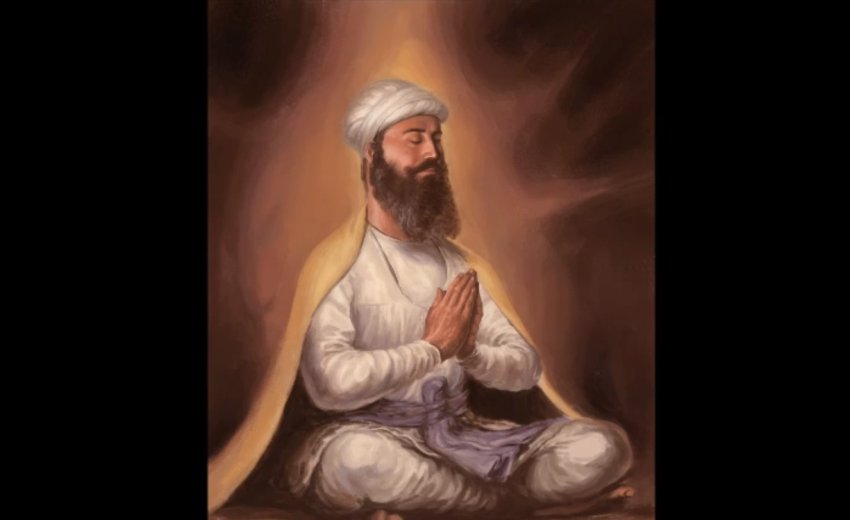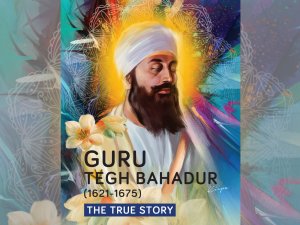As we commemorate the Shaheedi which “stabilized the world”* on 24 November, 2020. (*Bhai Gurdas JI)
Guru Tegh Bahadur understood the plight of the enfeebled and enslaved populace during his time and offered hope:
ਬਲੁ ਛੁਟਕਿਓ ਬੰਧਨ ਪਰੇ ਕਛੂ ਨ ਹੋਤ ਉਪਾਇ ॥ ਕਹੁ ਨਾਨਕ ਅਬ ਓਟ ਹਰਿ ਗਜ ਜਿਉ ਹੋਹੁ ਸਹਾਇ ॥੫੩॥
The strength is drained and [humanity] is in shackles; there is no solution. Says Nanak, now, the Lord is the Support; He will help, as He did the elephant [in Vedic lore]. ||53||ਬਲੁ ਹੋਆ ਬੰਧਨ ਛੁਟੇ ਸਭੁ ਕਿਛ ਹੋਤ ਉਪਾਇ ਨਾਨਕ ਸਭੁ ਕਿਛੁ ਤੁਮਰੈ ਹਾਥ ਮੈ ਤੁਮ ਹੀ ਹੋਤ ਸਹਾਇ॥੫੪॥
The strength [the will to resist oppression] has been restored, and the bonds have been broken; and the means [to liberation] are available. Nanak: everything is in Your hands, Lord; You are the Helper and Support [of all]. ||54||
(Salok Guru Teg Bahadur, SGGS Ang 1429)
Guru Tegh Bahadur offers hope to those in helpless situations. All Bani of the Guru needs to be understood bearing in mind the pitiful condition of the Indian Society at the time, summed-up in the Gurbani quoted above and recited with such devotion during the “Paatth da Bhog” at Gurdwaras.
The society had lost its direction and its will (inner strength) to resist oppression because it was following false ways. People had lost hope.
The Guru showed them the way to free themselves through total faith in the Creator Being: to fear none and frighten no-one:
ਭੈ ਕਾਹੂ ਕਉ ਦੇਤ ਨਹਿ ਨਹਿ ਭੈ ਮਾਨਤ ਆਨ ॥
One who does not frighten anyone, and who is not afraid of anyone elseਕਹੁ ਨਾਨਕ ਸੁਨਿ ਰੇ ਮਨਾ ਗਿਆਨੀ ਤਾਹਿ ਬਖਾਨਿ ॥੧੬॥
- says Nanak, listen, mind: call him spiritually wise. ||16||
The detachment preached in Guru ji’s Bani has to be understood as the pre-condition to a fearless disposition to be able to do one’s duty in life. It is not a message of opting out of society as preached by earlier Indian belief systems. In fact, the Guru shows the falsehood of such life-negating ideologies.
A study of Guru ji’s life shows that he was raj-yogi. He was named Tyag Mall after his birth on 1 April 1621. At the age of 14 years he took part in the battle of Kartarpur (April 1635) with such valour as to earn the title of Tegh Bahadur, the fearless master of the sword, from his great saint-warrior father, Guru Hargobind.
He was destined to earn the title of the invincible warrior: the martyr who defies death, conquers self to remain witness to the righteous cause, the truth, to the end. He laid down his life but kept his word to set an example for the Khalsa warriors who followed in his footsteps to defend dharam and human freedom.
In the words of Bhai Gurdas II, the Guru “stabilized the world”.
Guru Tegh Bahadur ji’s Bani is sometimes misinterpreted with a bias towards traditional Indian asceticism or renunciation. That the Guru’s Bani is bairagmaee. A closer study shows that the His Message does not preach any opt-out life style of the Indian tradition. Through detachment from the world-play (jagat tamasha) as a passing phase, He encourages full commitment to avail the opportunity offered by this human birth, for God-centred activism (dharam nebhaona, sewa and simran) which leads to salvation. In fact, He specifically rejects opt-out way of life:
ਕਾਹੇ ਰੇ ਬਨ ਖੋਜਨ ਜਾਈ ॥
Why do you go looking for Him in the forest?ਸਰਬ ਨਿਵਾਸੀ ਸਦਾ ਅਲੇਪਾ ਤੋਹੀ ਸੰਗਿ ਸਮਾਈ ॥੧॥ ਰਹਾਉ ॥
Although he is unattached, he dwells everywhere. He is always with you as your companion. ||1||Pause||ਪੁਹਪ ਮਧਿ ਜਿਉ ਬਾਸੁ ਬਸਤੁ ਹੈ ਮੁਕਰ ਮਾਹਿ ਜੈਸੇ ਛਾਈ ॥
Like the fragrance which remains in the flower, and like the reflection in the mirror,ਤੈਸੇ ਹੀ ਹਰਿ ਬਸੇ ਨਿਰੰਤਰਿ ਘਟ ਹੀ ਖੋਜਹੁ ਭਾਈ ॥੧॥
The Lord dwells deep within; search for Him within your own heart, O Siblings of Destiny. ||1||
~ Guru Tegh Bahadur SGGS ang 684 - (translation: searchgurbani.com)
Like the example of the elephant (gaj) used in the Gurbani quotation above, Guru ji gives numerous examples from popular Indian folklore which people were able to relate to. They were told how, according to the Vedic myth, those in hopeless situations were given hope and freedom. The society felt helpless like the elephant which according Vedic lore was caught in the tentacles of a giant octopus and was freed through meditation on the Lord’s Name. Other such examples are those of Panchali (Dropadi), Ajamal, Ganika and others. They all symbolize a fearful and helpless Indian society. The Guru shows the way how to overcome fear by seeking the protection of the Timeless Creator Being while doing what is right.
He introduces the concept of the mar-jeevda – one who first accepts death as a reality and then lives a life of fearless dignity. The ordinary people understood this message and were prepared for the sacrifices which lay ahead.
They sang the verse of Keso Bhatt:
Do not betray trust. Give your head but do not fail in your duty to do what is right.
(Bah Jinahn di pakariye.. Sar dije bah na chhoriye.. Tegh Bahadur bolya. Dhar payae dharam na chhodiye.)
Otherwise, Guru Tegh Bahadur was a Raj-Yogi who took full interest in family life. His daily routine is described, for example, by Koer Singh in Gurbilas Patshahi 10 at p 42.
(Broad translation):
The True Guru got up early in the morning (bhor jagain Satgur avtaari)
He recited Gurbani, did Naam simran and kattha/held discourse with the Sikhs (Potthi Granth dharain nij cheetah. Sikhvain Sikhan bhed puneeta.)
After that he paid full attention to hand-held and missile weapons. (Shastar astar pun pooj kraava)
Next he had food (Pun bhojansala meh jaahi).........
He rested and at the same time he also met and spoke to the [visiting] Sikhs/sangats [This also gave the opportunity to keep informed of what was going in distant places in India]....... (Paiy kichh karayn araam Dyala. Pun Sikhan kahayn bachan tatkala.....)They took the Guru for an outing and riding and hunting with dogs and hawks etc. Fearlessly, they went into the forest where there were many wild animals and they hunted bears and varieties of deer. (Laey Prabh ko ta swar karavay(n). Jai akhet so bibidh machaavay(n). Nirbhai jai(n) tahin bann maahi. Sunay sakaar jo adhik jahan hi. Suan sichaanan let apaara, Maaray reesh rojh jhankara.)
In the evening they returned for the evening religious service which included [Gurbani] singing in sangat (Nis Kao sadan apnay aavay(n). Beh jag karaj ko rall gaavayn).
(Translation by the author in Guru Tegh Bahadur: The True Story, page: 39)
The above daily routine followed by the Guru is instructive and clears many misunderstandings about the life of the Guru. After Aad Guru, Nanak Sahib, Guru Tegh Bahadur was the most widely travelled preacher to take the Guru-Jot’s revolutionary message of liberation to the people fearful of persecution spread by religious bigotry of Aurungzeb.
The Guru travelled far and wide to revive Guru Nanak’s Sangats for the final phase which led to the emergence of the Khalsa Panth under Guru Gobind Singh (Gur Sangat keeni Khalsa).
His martyrdom on 24 November 1675, laid the foundation for final phase of the emergence of the invincible God-centred mar-jeevda warriors, the Khalsa Akal Purakh ki Fauj (Khalsa, the Army of the Timesless Being).
(Further reading: Guru Tegh Bahadur: The True Story by this author available at the Sikh Missionary Society UK:
GuruTeghBahadurJi-TheTrueStory.pdf (sikhmissionarysociety.org)
Gurmukh Singh OBE
Ret’d Principal Civil Servant, UK
E-mail: [email protected]
Related article:
Siri Guru Tegh Bahadur: An Overview of His Life and Bani






